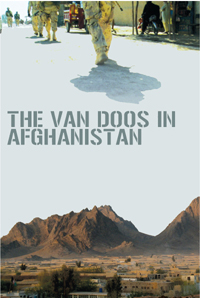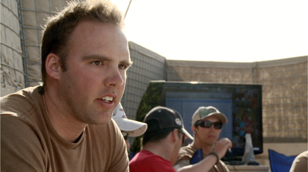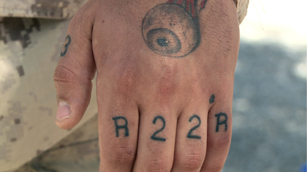| ________________
CM . . .
. Volume XX Number 6. . . .October 11, 2013 
 |
The Van Doos in Afghanistan.
Claude Guilmain (Director). Anne-Marie Rocher (Producer).
Montreal, PQ: National Film Board of Canada, 2013.
44 min., 5 sec., DVD, $34.95 (school price).
Order Number: 153C9912397
Subject Headings:
Afghanistan-Military operations.
Soldiers-Canada.
Afghan war, 2001-Personal narratives, Canadian.
Grades 11 and up / Ages 16 and up.
Review by Joanne Peters.
**** /4
excerpt:
|
| |
|

excerpt:
“What was your worst day? [Interviewer.]
When we lost our man, Pvt Bonenfant. It was really, … It was tough. But the guy stayed totally calm. He patched himself up, he didn’t scream or cry. He said, “Guys, I’m hit.” We followed orders. When we were fired on, we returned fire. When it stopped, one guy raced to him. We patched him up. It was the worst day, but it was still a good day.” [Master Corporal David Girard, A Company 1 R 22e R BG.]
Although the Canadian Forces are withdrawing from combat in that region, The Van Doos in Afghanistan offers a perspective on their past work with the Coalition forces. As the above quote indicates, every day brings the possibility of injury or death, but, equally, it offers these men and women the opportunity for professional skill and pride in the very hard work that they do. The most famous francophone organization within the Canadian Forces, the Van Doos get their nickname from the French word for “22nd ”, vingt-deuxieme. Formed during World War I, the Royal 22e Régiment has distinguished itself in combat operations since that time and counts amongst its ranks many well-known Canadian military, including the late Governor-General Georges Vanier.
 Panjwai, Kandahar, the Taliban – these names have dominated Canadian news coverage of the war in Afghanistan. In this documentary, they become more than names of places and of the enemy. The film opens with a panoramic view of a bleak, rocky landscape punctuated by scrubby green trees, set against a startlingly clear blue sky. An infantryman in a heavily-armoured vehicle buckles on a dusty beige helmet, his eyes shielded by dark glasses, his face protected from the sand by a mask. The vehicle lumbers out onto a road to begin its patrol work. In another view, we see a motorcycle fitted with a small truck bed, whizzing by a large herd of bleating sheep, both the driver and his half dozen passengers garbed in traditional Afghani dress. As we learn later in the film, those motorcycles are the prime means by which the insurgents transport bomb-making supplies. The military vehicle is bound for a village in the Panjwai district, the site of four major incidents that day. At the village, a soldier describes these insurgency incidents while others continue their patrol on foot. It’s all beige and grey, except for occasional spots of colour seen in items sold in the local bazaar or in the clothes worn by young Afghani children. Panjwai, Kandahar, the Taliban – these names have dominated Canadian news coverage of the war in Afghanistan. In this documentary, they become more than names of places and of the enemy. The film opens with a panoramic view of a bleak, rocky landscape punctuated by scrubby green trees, set against a startlingly clear blue sky. An infantryman in a heavily-armoured vehicle buckles on a dusty beige helmet, his eyes shielded by dark glasses, his face protected from the sand by a mask. The vehicle lumbers out onto a road to begin its patrol work. In another view, we see a motorcycle fitted with a small truck bed, whizzing by a large herd of bleating sheep, both the driver and his half dozen passengers garbed in traditional Afghani dress. As we learn later in the film, those motorcycles are the prime means by which the insurgents transport bomb-making supplies. The military vehicle is bound for a village in the Panjwai district, the site of four major incidents that day. At the village, a soldier describes these insurgency incidents while others continue their patrol on foot. It’s all beige and grey, except for occasional spots of colour seen in items sold in the local bazaar or in the clothes worn by young Afghani children.
Some patrols conclude without incident, and although the villages bear the scars of centuries of strife, with wrecked tanks and land-mine debris, the souvenirs of Russia’s unsuccessful struggle in Afghanistan, by 2011, conditions have improved. But, Afghanistan is an unbelievably poor country, cursed with a harsh climate. The extreme poverty has created a desperate situation for its populace. Cannabis and opium poppies are primary cash crops, but better money is made by the young men who plant IED’s (improvised explosive devices) in return for cash. Patrolling for these mines is the constant occupation of the 22e’s troops. The insurgents are highly adaptive; as Battle Captain Pascal Croteau stated, “They know all our weaknesses.”
Sometimes, despite all the training and all the precautions, there are casualties and deaths. Still, the resilience of these men and women is remarkable. In 2009, while participating in a foot patrol at night, Corporal Maxime Émond-Pépin lost an eye and sustained serious leg injury. The patrol’s medic had stepped on a land mine which blew off his leg. Despite his own injuries, after tying a tourniquet on himself, the medic directed the rest of the patrol on the care of Émond-Pépin prior to his evacuation to a field hospital. After surgery and several months of treatment, the Corporal returned to the field, first in an administrative position, and then, he was allowed to rejoin the infantry. What made him do it? He saw his situation as no different from that of a race car driver who crashes and suffers horrible burns and disfigurement: “I wouldn’t stop racing. I love what I do. Same for the infantry. The 22e is my life. I tattooed it on my heart, on me.” Tattooed on his left arm is his left eye, given in combat, and on his knuckles, “ R 2 2 R.”
 Life in the field is hot, dusty, and spartan. The Régiment’s camaraderie and esprit de corps is powerful, but they are keenly aware of the difficulties of being far from families, girlfriends and boyfriends, wives, husbands and children. “It’s a sacrifice everyone makes. Not just us, our families, too.” And sometimes, the sacrifice is ultimate. Like Corporal Yannick Scherrer’s comrades-in-arms, we experience the moment of silence which honours his memory and his regiment, and then, we see the gathering of troops at the Kandahar Airport as his coffin is borne to the airplane which we will return him to Canada.
Life in the field is hot, dusty, and spartan. The Régiment’s camaraderie and esprit de corps is powerful, but they are keenly aware of the difficulties of being far from families, girlfriends and boyfriends, wives, husbands and children. “It’s a sacrifice everyone makes. Not just us, our families, too.” And sometimes, the sacrifice is ultimate. Like Corporal Yannick Scherrer’s comrades-in-arms, we experience the moment of silence which honours his memory and his regiment, and then, we see the gathering of troops at the Kandahar Airport as his coffin is borne to the airplane which we will return him to Canada.
So, what keeps them going? Overwhelmingly, the Van Doos have a strong sense of mission, patriotism, and a powerful belief in the justness of the cause. Their commanders are motivated by the motto “Fight, convince, build”, but they are keenly aware that change, when it comes at all, will come slowly to Afghanistan. It is a land still very much divided by tribal loyalties, “a country closer to the Middle Ages [than the 21st century]... you have to expect that real change will take 25-50 years.” Nevertheless, the Royal 22e Regiment soldiers on.
This is a powerful documentary, on many levels. In a sense, we, as viewers, are embedded with the R 22e R: we see the soldiers, both on and off duty, and we also see the Afghanis whose society the soldiers are trying to build. The brutality of war is neither sugarcoated nor glossed over, but the Van Doos willingly accept the danger which is the daily challenge of their job. Even if one does not accept the reasons for Canadian involvement in the war, one must admire the courage of these men and women.
For senior high school students in World Issues and Modern History classes, The Van Doos in Afghanistan provides a recent perspective on the mission of this historic Canadian regiment. As Remembrance Day approaches, the film also offers a contemporary view of the realities of Canadian military life in the field, its triumphs and its losses.
Highly Recommended.
A retired high school teacher-librarian, Joanne Peters lives in Winnipeg, MB.

To comment
on this title or this review, send mail to cm@umanitoba.ca.
Copyright © the Manitoba Library Association. Reproduction for personal
use is permitted only if this copyright notice is maintained. Any
other reproduction is prohibited without permission.
NEXT REVIEW |
TABLE OF CONTENTS FOR THIS ISSUE
- October 11, 2013.
AUTHORS |
TITLES |
MEDIA REVIEWS |
PROFILES |
BACK ISSUES |
SEARCH |
CMARCHIVE |
HOME |

 Panjwai, Kandahar, the Taliban – these names have dominated Canadian news coverage of the war in Afghanistan. In this documentary, they become more than names of places and of the enemy. The film opens with a panoramic view of a bleak, rocky landscape punctuated by scrubby green trees, set against a startlingly clear blue sky. An infantryman in a heavily-armoured vehicle buckles on a dusty beige helmet, his eyes shielded by dark glasses, his face protected from the sand by a mask. The vehicle lumbers out onto a road to begin its patrol work. In another view, we see a motorcycle fitted with a small truck bed, whizzing by a large herd of bleating sheep, both the driver and his half dozen passengers garbed in traditional Afghani dress. As we learn later in the film, those motorcycles are the prime means by which the insurgents transport bomb-making supplies. The military vehicle is bound for a village in the Panjwai district, the site of four major incidents that day. At the village, a soldier describes these insurgency incidents while others continue their patrol on foot. It’s all beige and grey, except for occasional spots of colour seen in items sold in the local bazaar or in the clothes worn by young Afghani children.
Panjwai, Kandahar, the Taliban – these names have dominated Canadian news coverage of the war in Afghanistan. In this documentary, they become more than names of places and of the enemy. The film opens with a panoramic view of a bleak, rocky landscape punctuated by scrubby green trees, set against a startlingly clear blue sky. An infantryman in a heavily-armoured vehicle buckles on a dusty beige helmet, his eyes shielded by dark glasses, his face protected from the sand by a mask. The vehicle lumbers out onto a road to begin its patrol work. In another view, we see a motorcycle fitted with a small truck bed, whizzing by a large herd of bleating sheep, both the driver and his half dozen passengers garbed in traditional Afghani dress. As we learn later in the film, those motorcycles are the prime means by which the insurgents transport bomb-making supplies. The military vehicle is bound for a village in the Panjwai district, the site of four major incidents that day. At the village, a soldier describes these insurgency incidents while others continue their patrol on foot. It’s all beige and grey, except for occasional spots of colour seen in items sold in the local bazaar or in the clothes worn by young Afghani children.
 Life in the field is hot, dusty, and spartan. The Régiment’s camaraderie and esprit de corps is powerful, but they are keenly aware of the difficulties of being far from families, girlfriends and boyfriends, wives, husbands and children. “It’s a sacrifice everyone makes. Not just us, our families, too.” And sometimes, the sacrifice is ultimate. Like Corporal Yannick Scherrer’s comrades-in-arms, we experience the moment of silence which honours his memory and his regiment, and then, we see the gathering of troops at the Kandahar Airport as his coffin is borne to the airplane which we will return him to Canada.
Life in the field is hot, dusty, and spartan. The Régiment’s camaraderie and esprit de corps is powerful, but they are keenly aware of the difficulties of being far from families, girlfriends and boyfriends, wives, husbands and children. “It’s a sacrifice everyone makes. Not just us, our families, too.” And sometimes, the sacrifice is ultimate. Like Corporal Yannick Scherrer’s comrades-in-arms, we experience the moment of silence which honours his memory and his regiment, and then, we see the gathering of troops at the Kandahar Airport as his coffin is borne to the airplane which we will return him to Canada.